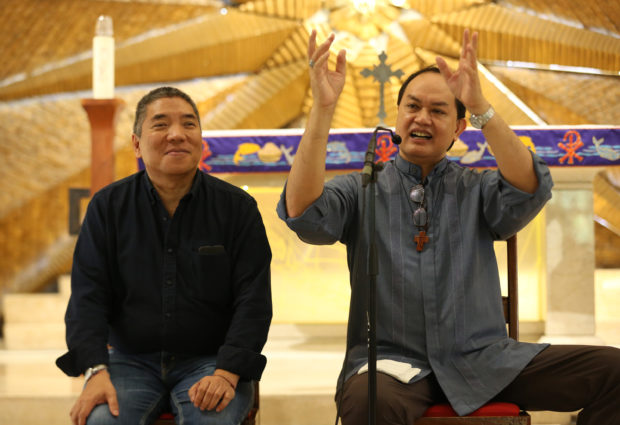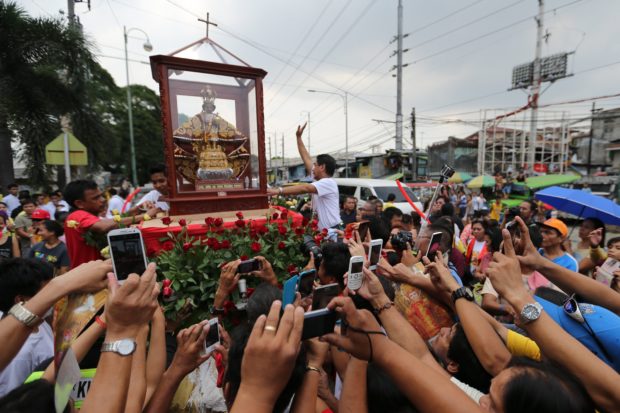PH Christianity at 500: ‘Little boy’ started it all
MANILA, Philippines — The image of the Santo Niño, the little boy Jesus in elaborate dress tucked in a revered corner of most Filipino homes, comes with 500 years of history that will be recalled next year when the country marks the coming of Christianity on March 16,1521.
But what is there to celebrate in the arrival of Portuguese explorer Ferdinand Magellan who brought with him the Cross and the Sword, President Rodrigo Duterte had asked, rebuking the need to remember the country’s colonial history, although he had issued in May, 2018, Executive Order No. 55, creating the National Quincentennial Committee.
In a speech last year in Cebu, the President said Magellan’s arrival brought not only Christianity, but also slavery in the hands of Spanish conquerors for almost 400 years.
But the country’s history must be remembered as it unfolded, both the good and the bad, historian and Inquirer columnist Ambeth Ocampo and Caloocan bishop Pablo David said in a lecture last week.
From the same Spanish-sowed Christian faith sprung the revolutionaries who fought for our freedom, they added.
Article continues after this advertisementThe mass baptism in Cebu has been considered by many as the birth of Christianity in the country. Raja Humabon was christened Carlos (after Charles V, the emperor of the Holy Roman Empire) while his wife was christened Juana. Hundreds of their subjects also received the sacrament.
Article continues after this advertisementAs baptismal gift, Juana was presented the image of the infant Jesus which she chose over the images of Christ and the Virgin Mary. Over time, the image was lost, until the arrival of another Spanish conquistador, Miguel Lopez de Legazpi in Cebu, whose crew found a Santo Niño statue amid some ruins.
‘Indio-genized’
The new Spanish arrivals took the discovery of the holy image as a sign that God approved of the conquest and the Christianization of what would become Spanish Philippines. A church was later built in the area where the relic was found, which became the present-day Basilica Menor del Santo Niño de Cebu.
From a symbol of conquest, the Santo Niño has evolved into a symbol of Every Filipino —dressed as a chef, a jeepney driver, pilot, judge—a familiar avatar guarding and blessing homes and offices.
“We made the Santo Niño in the image of our likeness,” Ocampo said. “In a sense, the Santo Niño was indigenized, ‘indio-genized.’ The foreign was made our own, not only as a form of accommodation, but also as a pattern of resistance.”
Not everyone agrees
Theologians have criticized the Filipinos’ popular devotion to the image that has been primped and paraded in religious festivals like a baby being showed off by doting parents.
Quoting an essay by Fr. Danny Pilario, David said that detractors see the Santo Niño as “infantilizing Jesus in order to domesticate him. Like any child, all that we expect him to do is to answer our prayers, nothing more.”
He explained “By keeping [Jesus] as a child, the criticism goes, and by highlighting his childlike obedience to his Father, we have also bracketed the adult prophetic Jesus who does not mince words to tell us the truth of our lives.”
At the same time, David noted, more than 80 percent of Catholics in the country are non-church goers, who have their own unique way of showing their religiosity. In most homes, the Santo Niño image is “like a friend,” whom one can talk to, pray to or even dance to.

RELIGION’S UPS AND DOWNS. Historian Ambeth Ocampo (left) and Caloocan Bishop Pablo David explain how the Christian faith bred both conquest and resistance. —JOAN BONDOC
Prayer and action
Again quoting Pilario, the Caloocan bishop described this devotion to Jesus, as “a curious mix of prayer and action, trust and resistance, mysticism and prophecy.”
In an editorial piece for the Catholic Bishops Conference of the Philippines (CBCP), David said that preparations for the 500th year of Christianity in the country have been ongoing since 2013.
“The hope is that in [all] these years, a renewal may take place in the Catholic faith of the Filipinos to make the quincentenaries’ celebration more meaningful,” he said. “We recognize that a lot still has to be improved in the way we live the faith. It still has to be purified, deepened and fortified,” David added.
To critics who see the coming of Christianity as “the start of the country’s subjugation,” David countered that through time, Filipinos have learned to distinguish between the Christian faith and Spanish colonialism.
He cited three Filipino clergymen—Fathers Mariano Gomez, Jose Burgos and Jacinto Zamora, collectively known as Gomburza—as among the patriots who had shed their blood in the struggle against the Spaniards.
“At some point, the faith that Filipinos had embraced was no longer alien to them. It had succeeded in taking root on the fertile ground of our innate spirituality as a people,” David said.
History could be used to unite people, but its subjectivity depends on the storytellers, acknowledged Ocampo, citing how the Spanish-produced film “Elcano and Magellan” drew public rebuke in its canceled screening in the country last year, after it allegedly depicted Lapu-Lapu as a villain for having slain Magellan.
Blind patriotism
“The Battle of Mactan may be significant to Filipinos, but it is merely a detail in the larger story of daring, exploration, and the first circumnavigation of the world,” he said in his column.
Ocampo noted that the outrage was a form of “blind patriotism,” adding that a review of textbook history would show that Magellan was not a conquistador, but an explorer commissioned by Spain to search for a new route to the so-called Spice Islands without trespassing on Portuguese territory.
Parsing history means remembering the famous quote by national hero Jose Rizal: “Ang hindi marunong lumingon sa pinanggalingan ay hindi makakarating sa pinaroroonan,” Ocampo said, noting that its authentic translation from Rizal’s juvenile play “El Consejo de los Dioses” (Council of the Gods) is: “I enter the future with a memory of the past.”
In these times when some people want us to move on from the past, to forgive and to forget, history should steer us to remember, the columnist said.
“We should learn our history in order to confront an uncertain future,” Ocampo added.
